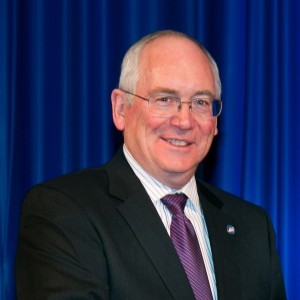By Norman Polmar
(Editor’s note: This is the 22nd in a series of blogs by Norman Polmar—author, analyst, and consultant specializing in the naval, aviation, and intelligence fields. Follow the full series here.)
Everybody likes Fred Rainbow. At least that is a widely held perception. At times it has gotten embarrassing. For example, when Fred was editor-in-chief of the Naval Institute Proceedings magazine, as award winners were called up to receive their prize they usually thanked their wife or girlfriend, for tolerating their time locked in a study spent writing an essay, or for typing the essay. But many, many prize winners went out of their way to thank Fred for his time in working with them to produce a “winner.”
Of course, not everyone was a fan of Fred, especially a couple of senior U.S. Navy admirals.
Fred, commissioned via Officer Candidate School, served on active duty in the Navy from 1971 to 1975 as an intelligence officer. Based in Norfolk, Virginia, for most of that time, he regularly flew to U.S. East Coast ports to brief crews of U.S. warships deploying to the Persian Gulf/Indian Ocean on the political-military situation in the area. He also flew to Mombasa, Kenya, to spend three months at sea aboard the destroyer Sellers (DDG 11) to get a first-hand look at the area. And, he edited the Navy publications Indian Ocean Fleet Book and Monthly Intelligence Digest.
When he left active duty in 1975, Fred went to New York, seeking a position with one of the major oil companies as a Middle East expert. He found that those firms did not have “intel staffs,” but relied mainly on people on the ground in the Middle East and commercial information services.
One of Fred’s friends recommended that he apply to the Naval Institute Proceedings, the privately published, professional magazine based in Annapolis. He did so and was promptly hired as an assistant editor of the magazine.
That July—part of the celebration of 200 years as a nation—New York City hosted “fleet week” for scores of U.S. and foreign warships. On 4 July, I rode a small boat, along with several other writers and journalists, zig-zaging among the ships anchored in the Hudson River. Fred, however, got to see the ships from the air. His father, Ab, was a fighter pilot in World War II and then a commercial airline pilot. He owned a Waco biplane and he and Fred—illegally—flew over the fleet. Only helicopters were allowed over the Hudson River and New York City that day. But one of Ab’s friends worked for the Federal Aviation Agency and a “glitch” in their computer listed the Waco as a helicopter!
That evening my wife and I hosted a small dinner party at Mama Leones, a popular Italian restaurant in Manhattan, for Fred and a few other writer-editor friends. Fred and I hit it off immediately. We kept in close contact and at his request I wrote a few articles for the Proceedings over the next couple of years.
In this period I became author of the Naval Institute’s reference book Ships and Aircraft of the U.S. Fleet, published at about three-year intervals. Fred suggested that I write a regular column for the Proceedings—the “U.S. Navy”—to regularly update the book. The first column appeared in November 1978 and continues, with my usually writing six to ten columns per year, depending upon my other commitments.
Beyond our social and professional contacts, Fred and I have “gone to sea” together. In 1982, we were aboard the British carrier Hermes, returning from the Falklands conflict, and later, with members of the Naval Institute staff, we went to sea in the carrier John F. Kennedy.
In 1985, Fred was named editor-in-chief of the Proceedings. By that time his “fans” included novelist Tom Clancy. Fred took Tom’s first telephone call to the Naval Institute when he was proposing a short article on MX missile basing, and Fred was a key player in Tom bringing his book The Hunt for Red October to the Naval Institute Press.
While Fred had numerous fans, he also had several disparagers. The Proceedings was begun in 1873 as an objective “forum” for naval-maritime issues. On at least three occasions, articles appeared in the magazine that “upset” the Navy’s senior leadership: One article was highly critical of the direction the Canadian Navy was going, another addressed the vulnerability of U.S. carriers operating in Northern waters against the Soviets, and a third was a satirical piece about political correctness in the military.
Senior Navy leaders brought considerable pressure upon the Naval Institute’s executives to fire Fred after these articles were published. Fortunately, Fred’s supporters—in and out of the Navy—immediately rallied to his support. His supporters’ friendship and efforts on his behalf included some of us coming to his home (uninvited), bringing wine, cheese, and good cheer for Fred and his wife, Peg. He weathered those storms.
Fred became director of periodicals and seminars in 1990, with responsibility for Naval History, a magazine that he initiated, as well as for the Proceedings and the Institute’s numerous seminars and history programs. He served as interim chief executive officer before departing the Naval Institute in 2005—exactly 30 years to the day after he had arrived there.
He immediately became vice president for education of the Armed Forces Communications-Electronics Association and executive director of the AFCEA Educational Foundation. Fred had started several joint activities with AFCEA while he was at the Naval Institute.
We are still close friends, although he has a much busier schedule than when he was at the Naval Institute. And, on occasion, he asks me to speak at AFCEA seminars. His time at AFCEA has increased by scores the number of people who like Fred Rainbow. And I am one of them.



Deborah Berger